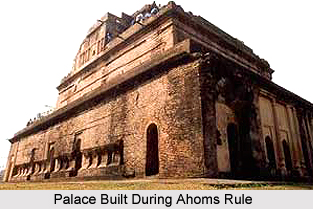 History of Jorhat District revealed from the chronological sequences associated that narrate its formation. Historical accounts suggest that "Jorhat" or "Jorehaut" means two hats - "Macharhat" and "Chowkihat" that existed on the two different banks of the River Bhogdoi. Jorhat was the last capital of the Ahom Kingdom. In 1794, Ahom king Gaurinath shifted the capital from Sibsagar (erstwhile "Rangpur") to Jorhat. This town was a flourishing and commercial metropolis but destroyed after a series of the Burmese invasions since 1817 until the arrival of the British force in the year 1824 under the stewardship of David Scott and Captain Richard.
History of Jorhat District revealed from the chronological sequences associated that narrate its formation. Historical accounts suggest that "Jorhat" or "Jorehaut" means two hats - "Macharhat" and "Chowkihat" that existed on the two different banks of the River Bhogdoi. Jorhat was the last capital of the Ahom Kingdom. In 1794, Ahom king Gaurinath shifted the capital from Sibsagar (erstwhile "Rangpur") to Jorhat. This town was a flourishing and commercial metropolis but destroyed after a series of the Burmese invasions since 1817 until the arrival of the British force in the year 1824 under the stewardship of David Scott and Captain Richard.
Further, the history of Jorhat District also specifies that the British Rule, though, was not free from rebellions and revolutions, contributed to the re-emergence of this historical town. It states that since the very first decade of the British rule some great revolutionists emerged like Gomdhar Konwar, Jeuram and Piyali Barua. The British system of administration came into vogue in 1839 with the establishment of a police station. During the Sepoy Mutiny of 1857, these great leaders were hanged in the year 1858. Further, in 1885, narrow gauge train services (Jorhat Provincial Railway) had come into operation and ultimately became instrumental in the rapid growth of tea industry of the region.
Moreover, according to the historical accounts of this district of Assam, the civil sub-division under Sibsagar district at Jorhat was formed in the year 1869. Further, this place was declared as the administration head quarter of the undivided Sibsagar district in the year 1911, which comprised the present Sibsagar, Jorhat and Golaghat District. It also consisted of some parts of Karbi-Anglong district with Major A. Playfare as the first Deputy Commissioner of this district.
On the north of the district, Brahmaputra River forms the largest riverine island of the world, Majuli; spreading over 924.6 sq km. Majuli had been the principal place of pilgrimage of Vaishnavites since the ages of the Ahom rules. There are several Satras resembling medieval monasteries headed by Satradhikars preaching and teaching Vaishnavism, which was initiated by Sankaradeva (1449-1568). Jorhat district is spreading over a huge area. Thus, it can be said that the history of Jorhat District is interesting with a series of important changes and events.



















